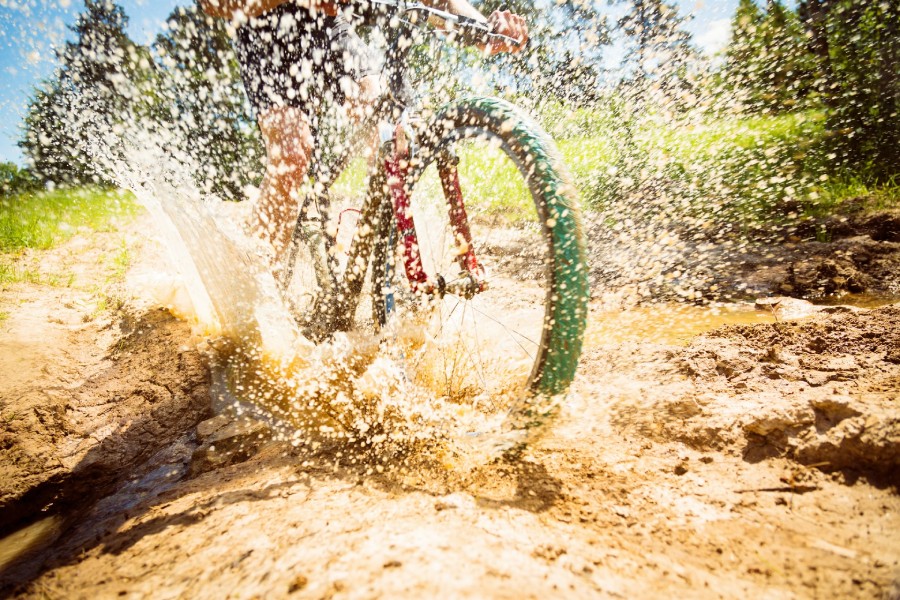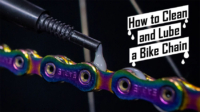How to Clean a Bike: A Comprehensive Step-by-Step Guide

Bike cleaning is an essential component of a regular bicycle maintenance routine. A clean bike looks better, runs more smoothly, and lasts longer.
All bikes are made up of many moving parts (especially the drivetrain), meaning that the mud, dust, or debris that catches in these areas can cause rapid deterioration of efficiency and faster wearing.
Taking five to ten minutes every week or two will make life much easier in the long run because if too much time passes between washes, the more time the next clean-up will take.
This article will cover what tools are needed for cleaning, some frequently asked questions, and how to clean your bike, the drivetrain, and a helmet.
How often should you clean your bike?
The frequency of washing a bike mostly depends on the amount of riding done and how much water, dirt, and debris accumulates.
We recommend a monthly wash at a minimum for road bikes. For mountain or gravel bikes, bi-weekly should be enough. However, if you’re riding on muddy trails, then consider a more frequent schedule such as weekly for off-road bikes and bi-weekly for road bikes.
Cleaning Supplies and Equipment

Park Tool bike cleaning brushes.
Having the right equipment makes bike cleaning fast and effortless. Here’s a list of the essential tools to get you started:
- Rags
- Water
- Two buckets
- Brushes (bike brushes or old toothbrushes)
- Sponges
- Soap or bike cleaner
- Chain degreaser
- Chain lube
In addition, some “nice-to-have” extra tools can make the process even easier:
- Bike stand
- Chain cleaning tool
- Garden hose
Cleaning a Bike Chain and Drivetrain

Foundation’s bike chain cleaning kit.
Any bike cleaning should start with the dirtiest part, the drivetrain.
Cleaning and lubing the chain and drivetrain is also the most crucial part of washing a bike. This system has the most moving parts and collects tons of dirt, debris, and mud from the road because of lube.
Best Bike Chain Lube (And How To Use It)
A dirty drivetrain causes the most significant loss of efficiency when riding and will be the first area to need replacing if you don’t care for it.
How to clean and lube a bike chain
1. Clean the drivetrain using a degreaser
- Start by applying the bike chain cleaner/degreaser to the chain and derailleurs (let the liquid sit for a couple of minutes for the best results)
- Use one brush for the plates, cassette, and derailleur(s). Bike brushes and a specific chain cleaning tool make it easier to get harder-to-reach dirt
- Rinse the whole drivetrain with water to remove loose dirt and excess bike chain degreaser
2. Lube the chain
-
- Ensure your chain is completely dry by running it through a dry rag
- Apply one drop of lube to each chain link slowly while turning the pedal backward and a drop on each of the jockey wheels
- Once each link is covered, wipe away any excess lube with a rag
3. Check for wear
This is also a great time to check your chain for wear and replace the chain if it is too worn to avoid damaging the cassette and chainrings as well.
How to clean a bike with household products?
It’s pretty common to clean a bike with household products. For example, use regular dish soap and water to clean the frame and components such as the brakes.
For cleaning the chain and drivetrain, you can use WD-40 as a degreaser. However, it is best to purchase some bike-specific lube for the best results when it comes time to lube.
How to clean a rusty bike chain?
Depending on how rusty the chain is, it may be possible to clean it without taking the chain off.
Apply a bike degreaser or WD-40, wait for 15 minutes, and use steel wool to scrub any light rusting off. If the rust persists, repeat the same process with lemon or lime juice.
If this doesn’t work, use a chain tool to take the chain off, soak it in a degreaser for 20 minutes, then scrub the rust off with steel wool.
How to clean a bike cassette?
If you don’t know how to clean bike gears, it is straightforward but takes a little time. The equipment needed is just an old rag (it can be used) and pipe cleaners (or a specialty cassette brush like this one from Park Tool).
- Remove your wheel and sit with it between your legs with something to gather the debris underneath.
- Use the edge of the rag gripped tight and pulled back and forth between each plate on the cassette.
- Once each one is done with the rag, repeat the process with the pipe cleaners, using a new one every couple of plates.
Can you use a WD40 to lubricate the bike chain?
No. Standard WD-40 works as a degreaser or rust removal solvent. This product is for cleaning rust or old lube from your chain. However, the brand has its own version of bicycle chain lube, which is different.
What to avoid?
- Allowing old lube to contaminate on the brake pads when cleaning the chain and drivetrain
- Applying lube all over the drivetrain, just the chain and a drop on each of the jockey wheels
- Excess lube on the drivetrain when finished
Cleaning the Bike
A quick bike wash can take as little as five minutes, whereas a long one could take 20. In general, it should take 10 minutes or less when done regularly.
How to clean a bike
How to clean a bike frame and components can change from person to person, but for us, the cleaning is done in three main steps:
1. Wash the frame and wheels with soap and water (avoid braking surfaces)
- Fill a bucket with warm water and add soap or a bike cleaning product.
- Take a sponge a wipe down the frame thoroughly.
- Rinse the frame with regular water using a clean bucket or hose (don’t use a pressure hose as this can damage the bearings)
2. Wipe the braking surfaces
- Use a clean rag to wipe any dirt or debris from the braking surfaces on rim brakes
3. Dry everything
- For speed, use clean rags to dry each part of the bike (if you have time, allow it to air dry)
An extra step (if you have time) would be to remove the wheels and clean them separately. This helps avoid brake pad contamination while cleaning the drivetrain.
How to clean a mountain bike
How often to clean a mountain bike depends on the type of trails and the season. However, as mentioned above, it’s best to do it every week or two weeks if riding regularly.
For cleaning mountain bikes, follow the steps in the section above and the next section on cleaning the chain and drivetrain, or check out the detailed video below.
One extra step is a basic maintenance protocol to keep an MTB fork running smoothly. Here’s a short video with step-by-step instructions.
How to clean disc brakes
Cleaning disc brakes is straightforward. However, it is vital to avoid contamination during a bike cleaning, as contaminated pads must be replaced. In addition, avoid the caliper and lever seals with the cleaning solution and don’t touch the rotors with fingers because the natural oils in the hands can cause issues with the brakes.
To clean follow these steps or check out this helpful video:
- Wipe away any dirt or debris on the system with some kitchen paper
- Use soap and water or a specialty bicycle brake cleaner and a clean rag
- Dry the system with another clean, dry rag
How to clean a carbon fiber bike?
Cleaning carbon fiber involves the same process as any frame material. The only difference is the finish may be more susceptible to scratches, meaning softer cleaning tools might be a good idea. In addition, don’t use any strong solvents to clean it.
How to clean rust off a bike?
There are three common ways to remove the rust from a bike:
- Apply a paste made of a 1:1 mix of baking soda and water to the rust. Wait 10-20 minutes and scrub the rust off with steel wool. Rinse the bike with water, then dry it.
- Put white vinegar in a spray bottle (with a teaspoon of baking soda optional), then follow the same process as above.
- Use a store-bought chemical rust remover and follow their instructions.
What to avoid?
- Contaminating the brake pads with oil from other parts of the bike
- Using high-pressure water for cleaning or rinsing
- Using the same brushes and sponges for the drivetrain and the rest of the bike
- Allowing your bike to remain wet after cleaning
- Submerging anything parts in water
- Corrosive cleaning products
Cleaning a Bike Helmet
How to clean a bike helmet?
To clean a bike helmet, gather the appropriate tools, including:
- A sink of warm soapy water
- A clean stiff-bristled brush or sponge
- A dishcloth
Use the dishcloth to clean the exterior in the sink, then use the brush to clean the inside lining and the straps. Once it is clean, rinse away the soap with fresh water.
It is okay to submerge the helmet temporarily to ensure you reach every area but don’t use hot water as this could affect the glue. Additionally, most helmets allow you to remove the inner padding, which can be washed on a cold/warm wash in the washing machine.
How to clean a smelly bike helmet?
Persistent helmet odor may require submerging the helmet lining in soapy water for a few hours before machine washing.
If this solution doesn’t work, allowing to soak in a bath of white vinegar and water (1:10 ratio) or a cup of water with a couple of tablespoons of baking soda should do the trick.
How to clean bike helmet straps?
As mentioned above, warm soapy water and a stiff brush are excellent for cleaning helmet steps.
Final Takeaways
Taking the time to clean your bike regularly will save you money, watts, and headache in the long run. In addition, a clean bike runs more efficiently, looks better, and the paint & components lasts much longer than a dirty one.
Once you have the correct tools and know-how, the process becomes quick and easy, taking no more than 10 minutes for a standard wash. A more thorough clean will take up to 30 minutes but isn’t required as frequently.
We hope, with the help of this article, you can save time and keep your bike in tip-top shape all year round!
Shop Bike Cleaners (REI) Shop Cleaning Kits (Jenson USA)



